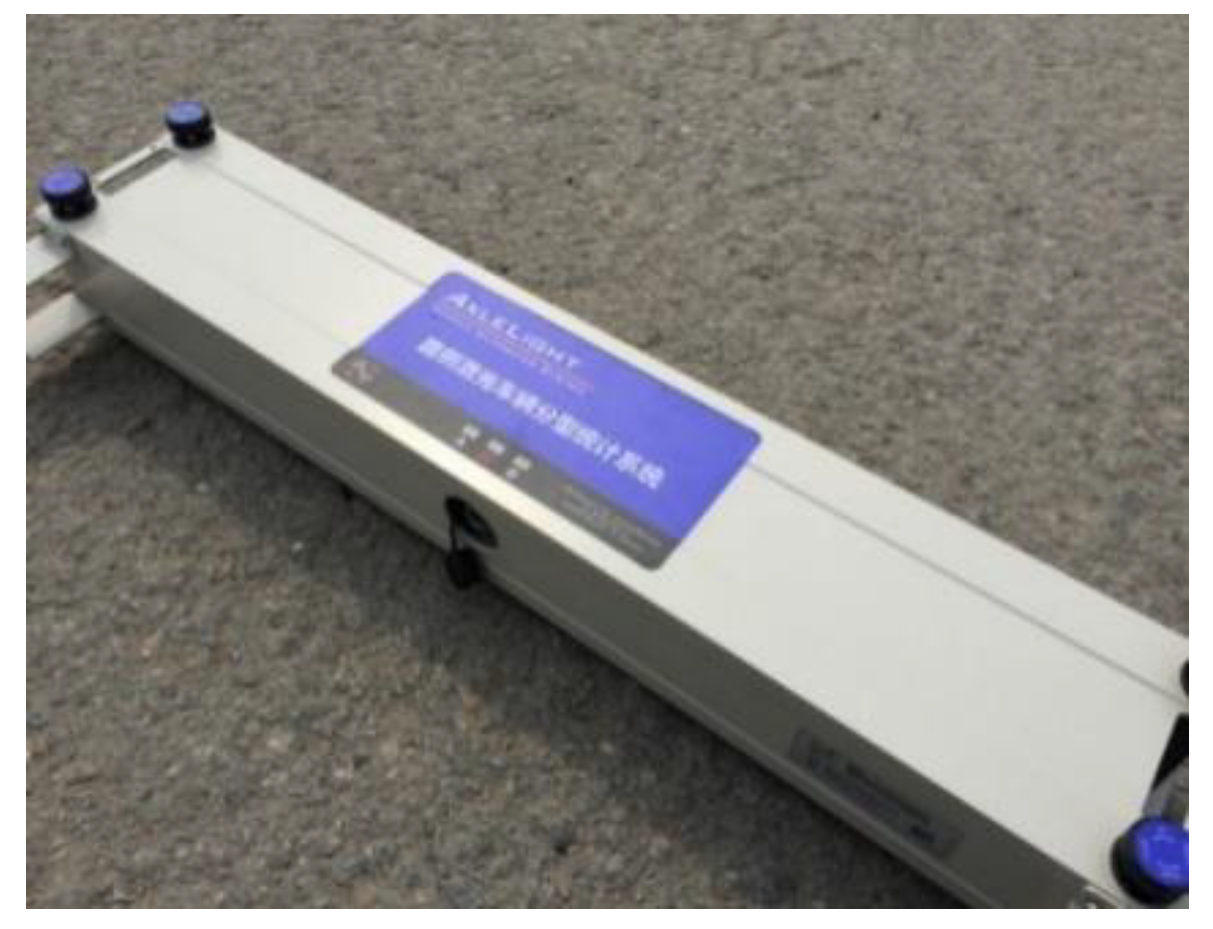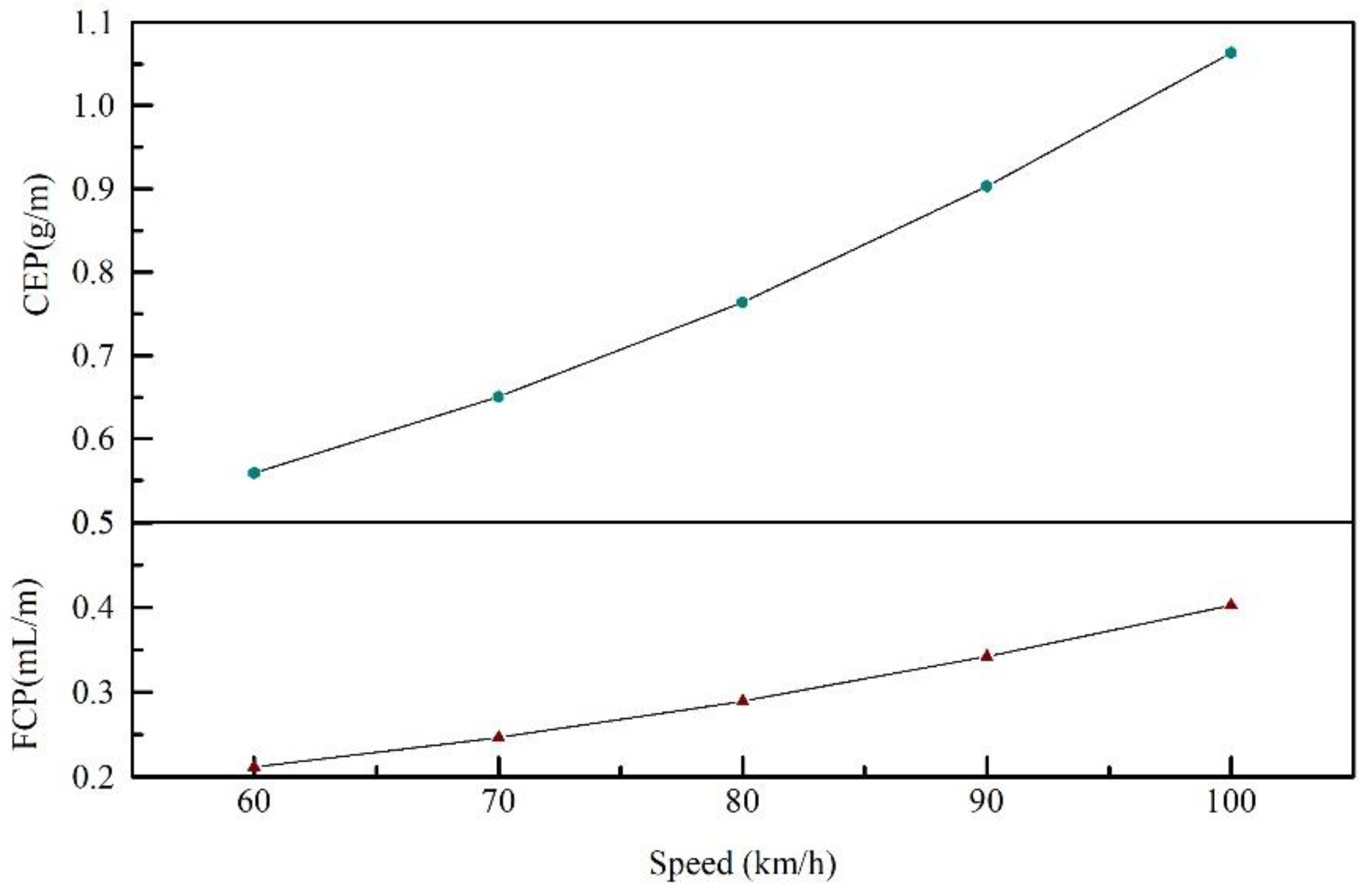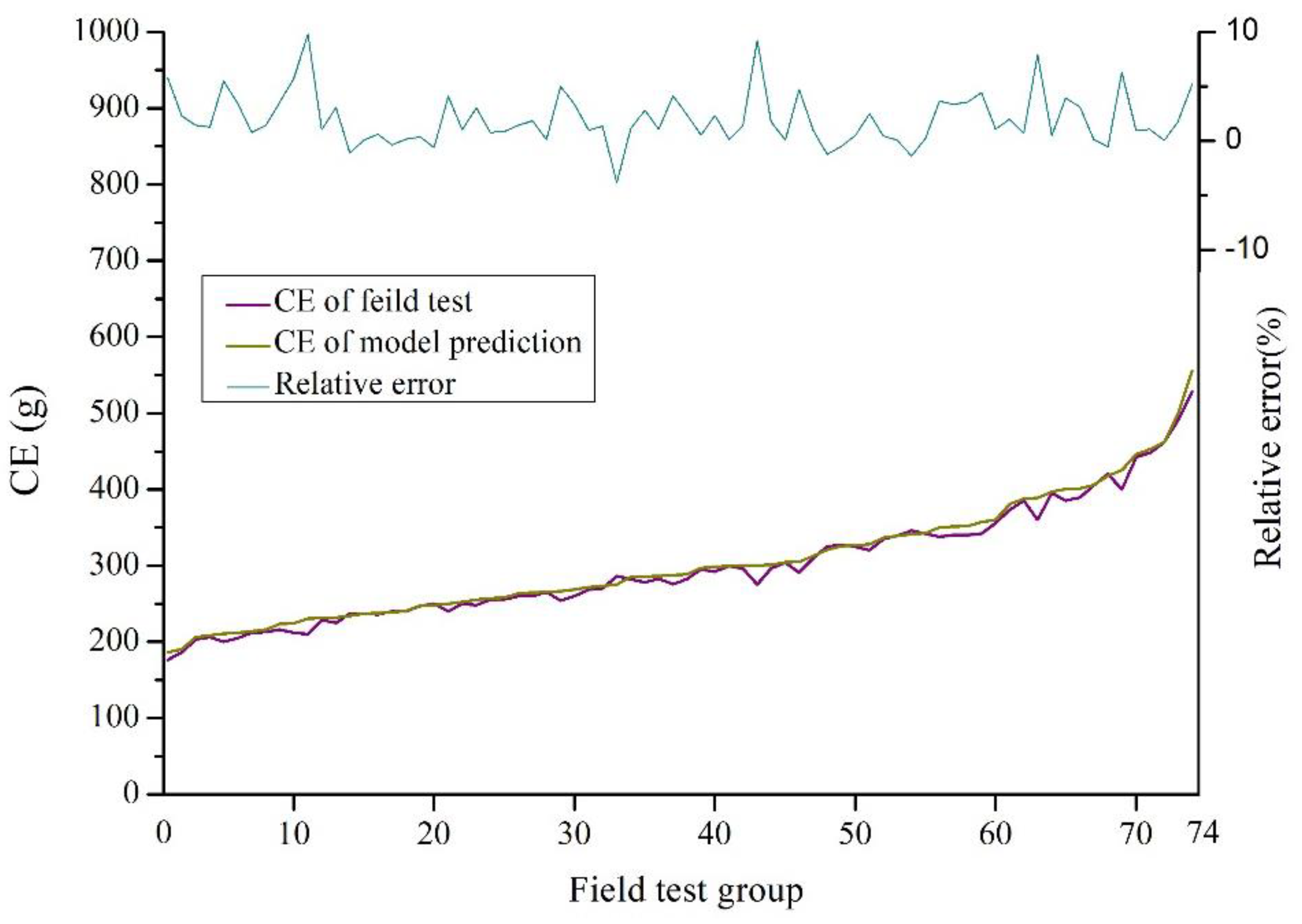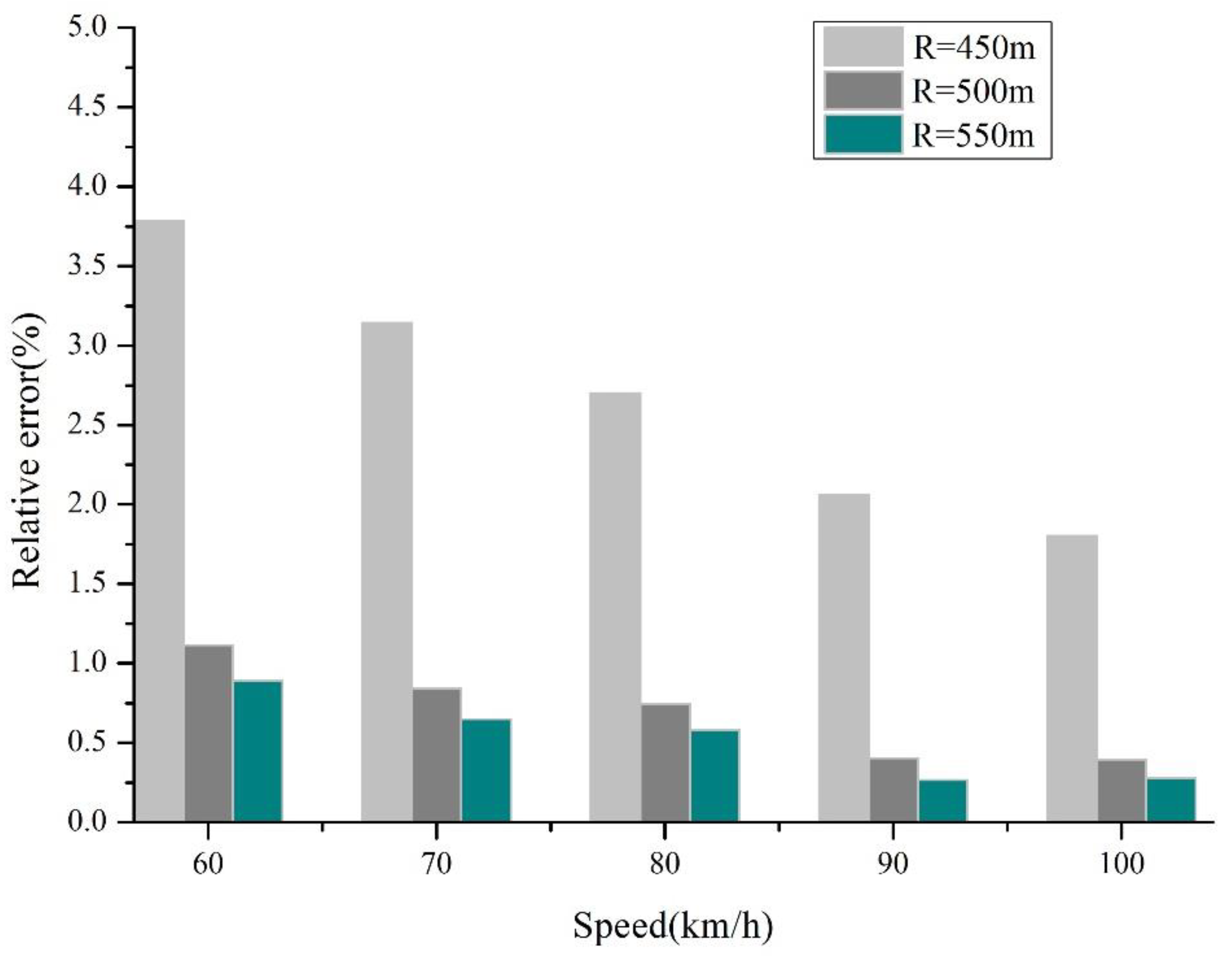Association of Carbon Emissions and Circular Curve in Northwestern China
Abstract
1. Introduction
2. Methods
2.1. Carbon Emission Conversion Method
2.2. Field Test
2.2.1. Test Vehicle and Instrument
2.2.2. Definition of Traffic Flow Pattern
2.2.3. Driver Selection
2.2.4. Route Selection
2.2.5. Other Factors
3. Results
3.1. Field Test Data
3.2. Carbon Emission Prediction Model
= L × (1.28 − 0.0029R + 2.738 × 10−6R2 − 0.0022 × L−0.223 − 0.00617V0 + 0.000117 V02),
3.3. The Minimum Curve Radius Affecting Carbon Emissions
4. Discussion
5. Conclusions
Author Contributions
Funding
Conflicts of Interest
References
- Harrington, W.; Mcconnell, V.D.; Cannon, M. A Behavioral Analysis of EPA’s MOBILE Emission Factor Model; Discussion Papers No 98-47; Resources for the Future: Washington, DC, USA, 1998. [Google Scholar]
- Huang, Y.; Hakim, B.; Zammataro, S. Measuring the carbon footprint of road construction using CHANGER. Int. J. Pavement Eng. 2013, 14, 11. [Google Scholar] [CrossRef]
- Zhai, H.; Frey, H.C.; Rouphail, N.M. Comparison of Flexible Fuel Vehicle and Life-Cycle Fuel Consumption and Emissions of Selected Pollutants and Greenhouse Gases for Ethanol 85 Versus Gasoline. J. Air Waste Manag. Assoc. 2009, 59, 912–924. [Google Scholar] [CrossRef] [PubMed]
- Guo, H.; Zhang, Q.Y.; Shi, Y. Evaluation of the International Vehicle Emission (IVE) model with on-road remote sensing measurements. J. Environ. Sci. 2007, 19, 818–826. [Google Scholar] [CrossRef]
- Abou-Senna, H.; Radwan, E.; Westerlund, K. Using a traffic simulation model (VISSIM) with an emissions model (MOVES) to predict emissions from vehicles on a limited-access highway. J. Air Waste Manag. Assoc. 2013, 63, 819–831. [Google Scholar] [CrossRef] [PubMed]
- Jiao, S.; Hou, C.; Li, Y.; Du, Q. Establishing the CO2 emission model of carbon neutral road based on gradient. Electrical and Control Engineering (ICECE). In Proceedings of the 2011 International Conference on Electrical and Control Engineering, Yichang, China, 16–18 September 2011; pp. 4494–4497. [Google Scholar]
- Sobrino, N.; Monzon, A. Towards Low-Carbon Interurban Road Strategies: Identifying Hot Spots Road Corridors in Spain. Sustainability 2018, 10, 3963. [Google Scholar] [CrossRef]
- Sobrino, N.; Monzon, A.; Hernández, S. Reduced Carbon and Energy Footprint in Highway Operations: The Highway Energy Assessment (HERA) Methodology. Netw. Spat. Econ. 2016, 16, 395–414. [Google Scholar] [CrossRef]
- Yang, W.; Alessandra, B.M. Evaluation of Eco-Driving Training for Fuel Efficiency and Emissions Reduction According to Road Type. Sustainability 2018, 10, 3891. [Google Scholar]
- Ko, M.; Lord, D.; Zietsman, J. Environmentally Conscious Highway Design for Crest Vertical Curves. Transp. Res. Rec. J. Transp. Res. Board 2012, 2270, 96–106. [Google Scholar] [CrossRef]
- Jia, X.; Xu, J.; Liu, X. Association of Carbon emissions and Expressway Longitudinal Slope in Northern China. J. Residuals Sci. Technol. 2017, 14, 177–183. [Google Scholar] [CrossRef]
- Ko, M. Incorporating Vehicle Emissions Models into the Geometric Highway Design Process: Application on Horizontal Curves. In Proceedings of the Transportation Research Board 94th Annual Meeting, Washington, DC, USA, 11 January 2015. [Google Scholar]
- David, L.; Ana María, P.; Alfredo, G. Impact of horizontal geometric design of two-lane rural roads on vehicle CO2 emissions. Transp. Res. Part D Transp. Environ. 2018, 59, 46–57. [Google Scholar]
- Barth, M.; K, B. Real-World Carbon Dioxide Impacts of Traffic Congestion. In Transportation Research Record: Journal of the Transportation Research Board; No. 2058; Transportation Research Board of the National Academies: Washington, DC, USA, 2010; pp. 163–171. [Google Scholar]
- Jiao, S.; Li, L.; Li, Y. Research on Design Index of Low-Carbon Highway Route Based on Game Theory. Adv. Mater. Res. 2013, 869, 1039–1043. [Google Scholar] [CrossRef]
- Bonneson, J.; Pratt, M. Model for Predicting Speed Along Horizontal Curves on Two-Lane Highways. Transp. Res. Rec. J. Transp. Res. Board 2009, 2092, 19–27. [Google Scholar] [CrossRef]
- Kang, M.; Shariat, S.; Jha, M. New highway geometric design methods for minimizing vehicular fuel consumption and improving safety. Transp. Res. Part C Emerg. Technol. 2013, 31, 99–111. [Google Scholar] [CrossRef]
- Hu, W.; Donnell, E.T. Models of acceleration and deceleration rates on a complex two-lane rural highway: Results from a nighttime driving experiment. Transp. Res. Part F Traffic Psychol. Behav. 2010, 13, 397–408. [Google Scholar] [CrossRef]
- May, J.; Favre, C. On-Road Testing and PEMS Data Analysis for two Euro 6 Diesel Vehicles. SAE Int. J. Fuels Lubr. 2014, 7, 919–934. [Google Scholar]
- Mamakos, A.; Bonnel, P.; Perujo, A. Assessment of portable emission measurement systems (PEMS) for heavy-duty diesel engines with respect to particulate matter. J. Aerosol Sci. 2013, 57, 54–70. [Google Scholar] [CrossRef]
- IPCC (Intergovernmental Panel on Climate Change). Guidelines for National Greenhouse Gas Inventories; Egglestone, H.S., Buendia, L., Miwa, K., Ngara, T., Tanabe, K., Eds.; Volume 2: Energy; Prepared by the National Greenhouse Gas Inventories Program; IGES: Tsukuba, Japan, 2006. [Google Scholar]
- National Development and Reform Commission, Climate Change Division. In Second National Communications on Climate Change in the People’s Republic of China; China Economic Publishing House: Beijing, China, 2013.
- Chinese Government. The First Two-Year Update Report on Climate Change in the People’s Republic of China. Available online: http://www.webcitation.org/75mAIC7ah (accessed on 28 January 2019).
- National Development and Reform Commission, Department of Climate Change, etc. Guidelines for the Preparation of Provincial Greenhouse Gas Inventories (Trial); NDRC: Beijing China, 2011.
- Arti, C.; Sharad, G. Urban real-world driving traffic emissions during interruption and congestion. Transp. Res. Part D 2016, 43, 59–70. [Google Scholar]
- Yang, S.; Ji, Y.; Zhang, D. Equilibrium between Road Traffic Congestion and Low-Carbon Economy: A Case Study from Beijing, China. Sustainability 2019, 11, 219. [Google Scholar] [CrossRef]
- Technical Standards for Highway Engineering (JTG B01-2014); China Standard Press: Beijing, China, 2014.
- Transportation Research Board (TRB). Highway Capacity Manual; Special Report 87; National Research Council: Washington, DC, USA, 2000. [Google Scholar]
- Design Specification for Highway Alignment (JTG D20-2017); China Standard Press: Beijing, China, 2017.
- Echaveguren, T.; Bustos, M.; de Solminihac, H. Assessment of horizontal curves of an existing road using reliability concepts. Can. J. Civ. Eng. 2005, 32, 1030–1038. [Google Scholar] [CrossRef]
- Song, G.; Yu, L. Estimation of Fuel Efficiency of Road Traffic by Characterization of Vehicle-Specific Power and Speed Based on Floating Car Data. Transp. Res. Rec. J. Transp. Res. Board 2009, 2139, 11–20. [Google Scholar] [CrossRef]
- Zhai, H.; Frey, H.C.; Rouphail, N.M. A Vehicle-Specific Power Approach to Speed- and Facility-Specific Emissions Estimates for Diesel Transit Buses. Environ. Sci. Technol. 2008, 42, 7985–7991. [Google Scholar] [CrossRef] [PubMed]






| The Degree of Road Service Level | v/C | Design Speed (km/h) | ||
|---|---|---|---|---|
| 120 | 100 | 80 | ||
| Maximum Traffic [pcu/(h·ln)] | Maximum Traffic [pcu/(h·ln)] | Maximum Traffic [pcu/(h·ln)] | ||
| 1 | v/C ≤ 0.35 | 750 | 730 | 700 |
| 2 | 0.35 < v/C ≤ 0.55 | 1200 | 1150 | 1100 |
| 3 | 0.55 < v/C ≤ 0.75 | 1650 | 1600 | 1500 |
| 4 | 0.75 < v/C ≤ 0.9 | 1980 | 1850 | 1800 |
| 5 | 0.90 < v/C ≤ 1.0 | 2200 | 2100 | 2000 |
| 6 | v/C > 1.0 | 0~2200 | 0~2100 | 0~2000 |
| The Degree of Road Service Level | v/C | Design Speed (km/h) | ||
|---|---|---|---|---|
| 100 | 80 | 60 | ||
| Maximum Traffic [pcu/(h·ln)] | Maximum Traffic [pcu/(h·ln)] | Maximum Traffic [pcu/(h·ln)] | ||
| 1 | v/C ≤ 0.3 | 600 | 550 | 480 |
| 2 | 0.3 < v/C ≤ 0.5 | 1000 | 900 | 800 |
| 3 | 0.5 < v/C ≤ 0.7 | 1400 | 1250 | 1100 |
| 4 | 0.7 < v/C ≤ 0.9 | 1800 | 1600 | 1450 |
| 5 | 0.9 < v/C ≤ 1.0 | 2000 | 1800 | 1600 |
| 6 | v/C > 1.0 | 0~2000 | 0~1800 | 0~1600 |
| Variable | Specification |
|---|---|
| Vehicle Type | heavy truck ( type CA5310CCYP66K2L7T4E5, Jiefang, Jilin, China) |
| Vehicle Mass (t) | 30 |
| Heavy truck age | 3 years |
| Fuel | Conventional diesel fuel, type is 10# |
| Driving age | 10–15 years |
| Data | 2 December 2017, to 5 January 2018, 9:00 am to 1 pm on weekdays |
| Temperature (°C) | −3~−5 |
| Relative humidity (%) | 75~85 |
| No. | R (m) | L(m) | V0 (km/h) | FC (mL) | CE(g) |
|---|---|---|---|---|---|
| 1 | 200 | 242.141 | 60.21 | 79 | 206 |
| 2 | 245 | 301.099 | 61.24 | 92 | 240 |
| 3 | 260 | 295.055 | 62.98 | 86 | 225 |
| 4 | 285 | 370.801 | 61.45 | 104 | 270 |
| 5 | 300 | 296.470 | 62.68 | 82 | 213 |
| … | … | … | … | … | … |
| 95 | 600 | 651.348 | 100.13 | 267 | 695 |
| 96 | 700 | 640.806 | 100.22 | 262 | 681 |
| 97 | 800 | 935.096 | 102.2 | 384 | 999 |
| 98 | 900 | 868.356 | 101.21 | 356 | 926 |
| 99 | 1000 | 1251.348 | 103.49 | 511 | 1330 |
| Independent Variables | Unary Regression Model | One-Way ANOVA | BIC | Optimal Model | ||
|---|---|---|---|---|---|---|
| R2 | F | P | ||||
| R | f (R)1 = 0.823 − 0.001R | 0.602 | 514.953 | 0.003 | 320.478 | f (R)2 |
| f (R)2 =0.913 − 0.001R + 6.748 × 10−7R2 | 0.753 | 539.017 | 0.001 | 176.924 | ||
| f (R)3 = 0.147 − 0.006R − 1.756e−5R2 + 1.610 e−8R3 | 0.628 | 522.452 | 0.003 | 298.969 | ||
| L | f (L)1 = − 0.110ln(L) + 0.907 | 0.649 | 314.977 | 0.001 | 403.905 | f (L)3 |
| f (L)2 = 0.950 − 0.001 L + 7.538e−7L2 | 0.628 | 300.751 | 0.020 | 462.067 | ||
| f (L)3 = 1.507 L−0.223 | 0.687 | 533.781 | 0.001 | 251.620 | ||
| V0 | f (V0)1 = 0.627 + 0.004V0 | 0.565 | 963.273 | 0.022 | 172.714 | f (V0)2 |
| f (V0)2 = 1.193 − 0.010V0 + 8.571e−5V02 | 0.689 | 517.542 | 0.011 | 155.439 | ||
| Speed (km/h) | The Radius of Circular Curve | Flat Line | |||||||
|---|---|---|---|---|---|---|---|---|---|
| 200 | 250 | 300 | 350 | 400 | 450 | 500 | 550 | ||
| 60 | 86.035 | 77.696 | 70.725 | 65.124 | 60.891 | 58.028 | 56.533 | 56.408 | 55.910 |
| 70 | 95.075 | 86.736 | 79.765 | 74.164 | 69.931 | 67.068 | 65.573 | 65.448 | 65.024 |
| 80 | 106.455 | 98.116 | 91.145 | 85.544 | 81.311 | 78.448 | 76.953 | 76.828 | 76.383 |
| 90 | 120.175 | 111.836 | 104.865 | 99.264 | 95.031 | 92.168 | 90.673 | 90.548 | 90.307 |
| 100 | 136.235 | 127.896 | 120.925 | 115.324 | 111.091 | 108.228 | 106.733 | 106.608 | 106.312 |
| Speed (km/h) | The Radius of Circular Curve | |||||||
|---|---|---|---|---|---|---|---|---|
| 200 | 250 | 300 | 350 | 400 | 450 | 500 | 550 | |
| 60 | 53.881 | 38.966 | 26.498 | 16.479 | 8.909 | 3.788 | 1.115 | 0.890 |
| 70 | 46.215 | 33.390 | 22.670 | 14.056 | 7.547 | 3.143 | 0.844 | 0.651 |
| 80 | 39.370 | 28.452 | 19.326 | 11.993 | 6.452 | 2.703 | 0.746 | 0.582 |
| 90 | 33.074 | 23.839 | 16.121 | 9.918 | 5.231 | 2.060 | 0.405 | 0.266 |
| 100 | 28.147 | 20.302 | 13.746 | 8.477 | 4.495 | 1.802 | 0.396 | 0.278 |
© 2019 by the authors. Licensee MDPI, Basel, Switzerland. This article is an open access article distributed under the terms and conditions of the Creative Commons Attribution (CC BY) license (http://creativecommons.org/licenses/by/4.0/).
Share and Cite
Dong, Y.; Xu, J.; Li, M.; Jia, X.; Sun, C. Association of Carbon Emissions and Circular Curve in Northwestern China. Sustainability 2019, 11, 1156. https://doi.org/10.3390/su11041156
Dong Y, Xu J, Li M, Jia X, Sun C. Association of Carbon Emissions and Circular Curve in Northwestern China. Sustainability. 2019; 11(4):1156. https://doi.org/10.3390/su11041156
Chicago/Turabian StyleDong, Yaping, Jinliang Xu, Menghui Li, Xingli Jia, and Chao Sun. 2019. "Association of Carbon Emissions and Circular Curve in Northwestern China" Sustainability 11, no. 4: 1156. https://doi.org/10.3390/su11041156
APA StyleDong, Y., Xu, J., Li, M., Jia, X., & Sun, C. (2019). Association of Carbon Emissions and Circular Curve in Northwestern China. Sustainability, 11(4), 1156. https://doi.org/10.3390/su11041156





